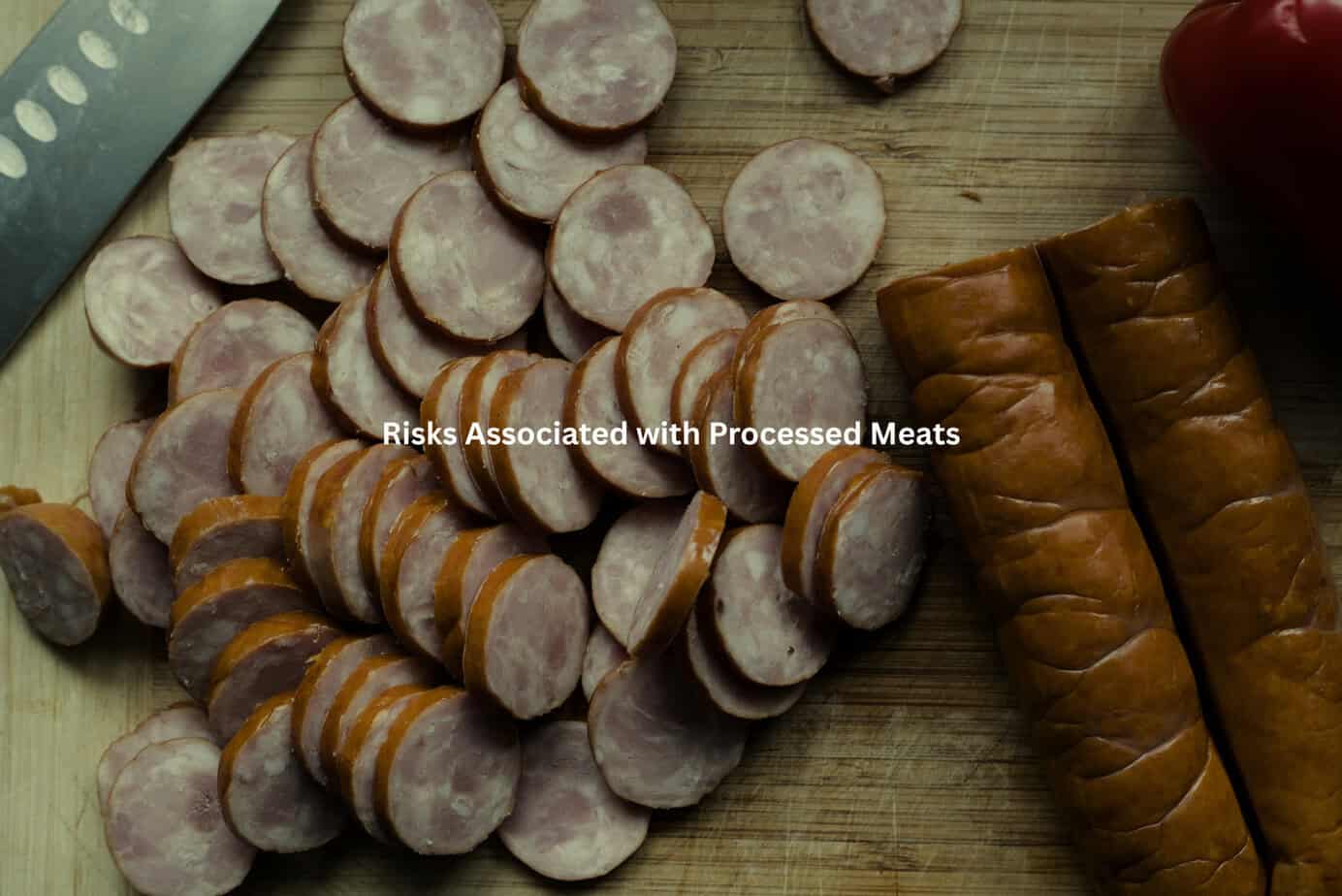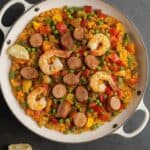The meal is easy to prepare, filling, and quick to eat, which explains its popularity. But relying only on these foods long term can mean too much sodium and not enough variety. For best results, use this combo as part of a balanced, flexible diet.
Key Takeaway
- High-protein, low-carb meals like chicken sausage with mustard can help with satiety, muscle maintenance, and weight management.
- Watch for processed meat risks, sodium, and lack of dietary diversity if using this meal often.
- Using this meal as a convenient option within a broader, balanced diet works better than strict repetition.
Understanding the Chicken Sausage with Mustard Diet
I first came across this meal on TikTok, just a paper plate with chicken sausage slices, mustard, and cottage cheese. It looked plain but oddly satisfying. Curious, I decided to try it for a week and document how it affected my appetite, weight, and energy levels
Core Components and Serving Style
The meal itself is basic: chicken sausage, mustard, cottage cheese, and raw vegetables (usually cucumbers or bell peppers). The sausage, sliced into bite-sized coins, is the main attraction, dipped in mustard for flavor. Cottage cheese offers a soft, tangy side, while the vegetables add crunch and color.A typical serving goes like this:
- 2 chicken sausages (about 120-150g total, 180–210 calories, 20–24g protein)
- 2 tablespoons mustard (10–20 calories, basically zero fat)
- ½ cup cottage cheese (100 calories, 12g protein, 5g fat, 100mg calcium)
- 1 cup raw vegetables (30–50 calories, 2–3g fiber)
Everything gets arranged as a snack plate or lunch bowl. No bread, no pasta, no rice. The grain-free, low-carb approach is part of the appeal, especially for anyone tracking calories or carbs.
Viral Trend and Popularity on Social Media
The diet started with a TikTok video from Tiffany Magee, who claimed she lost 80 pounds eating this meal every day for lunch. That’s the story. The video spread, then others joined in, posting photos and videos, some for weight loss, others for easy prep.Why did it catch on?
- It’s simple. No cooking skills needed, barely any cleanup.
- High in protein, low in carbs, two features popular among dieters.
- Feels fresh compared to heavy, processed meals.
- There’s a bit of novelty in eating sausage and mustard for lunch, like breaking a rule.
Still, the meal’s popularity says as much about what people want, convenience, quick results, some sense of control, as it does about what works nutritionally.
Nutritional Profile and Health Benefits
I tried the meal myself for a week. The first thing I noticed: how full I felt, with barely any hunger before dinner. The second thing: how salty everything tasted. Nutritional details matter here, and not just for weight loss.
Protein Content and Its Role in Satiety and Metabolism
Protein is the meal’s headline. Both chicken sausage and cottage cheese are rich sources. A single serving easily hits 30–36 grams of protein, more than enough for lunch.According to Dr. Nancy Rodriguez, a professor of nutritional sciences at the University of Connecticut, “a higher protein intake helps preserve lean muscle mass during calorie restriction.” In my own trial, I found that I stayed full for hours after this meal, likely due to the 30+ grams of protein from the sausage and cottage cheese combo.
Caloric and Fat Considerations
Compared to pork sausage, chicken sausage comes out ahead for dieters: less fat, fewer calories, still plenty of flavor and protein. A pork link might have 250–300 calories and 20g fat. Chicken sausage usually cuts that nearly in half, and the fat is mostly unsaturated.Mustard is almost calorie-free. A tablespoon has less than 10 calories [1]. It contains antioxidants (like sinigrin) and anti-inflammatory compounds, though the amounts are small. Still, mustard’s sharp flavor means you use less sauce than with mayo or ketchup.Cottage cheese adds protein and calcium, but watch the fat content. Full-fat versions are creamier but calorie-dense. Low-fat or 1% cottage cheese gives you the protein and calcium with half the fat.
Fiber and Micronutrient Support from Vegetables and Dairy
Raw vegetables are more than filler. One cup of sliced cucumbers, peppers, or carrots adds roughly 2–3 grams of fiber, plus vitamins A and C, potassium, and water for hydration. Fiber supports gut health, keeps you regular, and helps with fullness [2].Cottage cheese is a solid source of calcium, about 100mg per half-cup, roughly 10% of your daily need. That supports bone health, especially important if you’re losing weight. The meal, with its mix of protein, fiber, and micronutrients, checks a lot of boxes for a low calorie meal.
Potential Health Concerns and Dietary Limitations
I liked the convenience, but by Day 5, I missed bread. My ankles looked a little puffy. The nutrition label on the sausage said 600 mg sodium per link. That’s just one problem.
Sodium Levels and Cardiovascular Implications
Chicken sausage and cottage cheese are both high sodium foods. Two sausages plus half a cup of cottage cheese can hit 1,000mg sodium, almost half the American Heart Association’s 2,300mg daily limit. High sodium diets are linked to high blood pressure and higher risk for heart disease and stroke.If you already have blood pressure concerns, this meal might not fit every day. Drinking more water helps a little, but it’s no substitute for choosing lower sodium foods.
Risks Associated with Processed Meats

Chicken sausage is still processed meat. Studies tie frequent processed meat consumption (sausage, deli meats, bacon) to increased risk of cancer and cardiovascular disease. The risk isn’t from one meal, but from eating these foods daily, week after week.
Expert advice is to eat processed meats sparingly. The World Health Organization, for example, recommends keeping processed meats to a minimum, maybe once or twice a week, not every day. This doesn’t mean chicken sausage is off-limits, but it shouldn’t be your only protein source.
Nutritional Deficiencies and Sustainability Challenges
The diet’s narrow focus means missing out on some nutrients. No whole grains, no healthy fats, limited fruits. That can lead to micronutrient deficiencies over time, vitamin E, magnesium, omega-3s, and some antioxidants.Gut health also depends on fiber variety. Different fibers support different gut bacteria. A fiber rich diet means mixing vegetables, beans, whole grains, and fruits, not just cucumbers and bell peppers. Long-term, a repetitive diet like this can actually lower gut health.There’s also the boredom factor. Eating the same thing every day gets old. Most people stop after a few weeks, either for taste or because they notice side effects (like constipation, cravings, or fatigue).
Practical Recommendations for Incorporation
She made the meal for lunch twice a week, then started to experiment. Sliced avocado one day, a handful of walnuts the next. She swapped Greek yogurt for cottage cheese. The meal worked better as part of a bigger routine.
Emphasizing Dietary Balance and Food Variety

Credits: Myprotein
For a truly balanced diet, you need:
- Multiple protein sources: chicken, fish, eggs, beans, tofu
- Different vegetables: leafy greens, tomatoes, root vegetables, cruciferous types
- Whole grains: brown rice, oats, whole wheat, quinoa
- Healthy fats: olive oil, nuts, seeds, avocado
Mixing things up lowers your processed meat intake, fills nutrient gaps, and helps you stick with healthy eating habits long term.You can:
- Use chicken sausage with mustard and vegetables for lunch two or three times a week.
- Rotate in hard-boiled eggs, grilled chicken, tuna, or plant-based sausages.
- Add a piece of fruit or a handful of nuts for antioxidants and healthy fats.
- Include a small whole grain wrap or crackers if you need more energy or fiber.
Moderation and Enjoyment in Meal Planning
Instead of repeating the same meal every day, treat it as a convenient healthy meal option. This makes meal prep simpler without sacrificing variety.Some practical tips:
- Buy lower sodium chicken sausage and cottage cheese if possible (look for <350 mg sodium per serving).
- Add a squeeze of lemon, chopped herbs, or hot sauce for flavor variety.
- Use Greek yogurt as a substitute for cottage cheese, or try hummus for a plant-based dip.
- Prep raw veggies in advance so you can grab and go.
- Listen to your body, if you start craving carbs or feel constipated, add more variety or fiber.
The goal isn’t to follow a strict “chicken sausage with mustard diet” forever. It’s to use this meal when you need something quick, protein-rich, and filling, then move on to other healthy lunch ideas the rest of the week.
Advice for Sustainable, Healthy Eating
There’s something to be said for routines. But the best diets aren’t rigid. They flex with your life, your health needs, and your taste. Chicken sausage with mustard, cottage cheese, and raw veggies can be part of that, especially if you like the flavor and the convenience.Mix it up. Eat a rainbow of foods. Pay attention to sodium and processed meat intake. Make your meals work for you, not the other way around. And if TikTok inspires you to try something new, great, just don’t forget the basics: balance, variety, and enjoyment.Try making the meal once or twice this week, then put your own spin on it. Add something green, something crunchy, something you actually crave. That’s how food becomes both healthy and yours.
Frequently Asked Questions
1. Can I eat the chicken sausage with mustard diet every day and still be healthy?
Eating this meal daily for a short stretch probably will not hurt most healthy adults, but repeating it for weeks or months increases your risk of missing key nutrients and getting too much sodium. It’s better to rotate this meal with others that include whole grains, fruits, and different protein sources to keep your diet balanced and more sustainable.
2. Is chicken sausage with mustard really good for weight loss?
Yes, mainly because it’s high in protein and low in calories, so you feel full without overeating. But real, lasting weight loss comes from your overall eating habits and calorie intake over time, not just one meal. Using this meal as part of a lower calorie, nutrient-dense routine can help with weight loss, but variety matters.
3. Are there healthier alternatives to chicken sausage I could use in this meal?
Definitely. Grilled chicken breast, hard-boiled eggs, tofu, or even plant-based sausages can replace chicken sausage and lower your intake of processed meats and sodium. You could also swap cottage cheese with Greek yogurt or add more raw vegetables for extra fiber.
4. How can I lower the sodium in this meal?
Choose lower sodium chicken sausage and cottage cheese, rinse cottage cheese under cold water to remove some salt, and limit the mustard to one or two tablespoons. Adding more fresh vegetables and drinking extra water also helps your body handle sodium better, but ingredient selection makes the biggest difference.
5. What should I add to this meal to make it more balanced?
Include a serving of whole grains (like brown rice or whole wheat crackers), add a handful of nuts or seeds for healthy fat, and mix up the vegetables for more vitamins and fiber. Adding a piece of fruit rounds out the meal with antioxidants and natural sweetness, making it more satisfying and nutritious.
Conclusion
Chicken sausage with mustard, cottage cheese, and crisp vegetables offer a quick, filling lunch that can help with weight loss if you enjoy the flavors and crave simplicity. But eating this meal every day is not a magic fix, it is just one tool. For lasting results and better overall health, rotate it with other whole foods, watch the sodium, and keep your plate colorful and varied. Practical, flexible eating always works better than rigid rules.
References
- https://www.eatthismuch.com/calories/mustard-220
- https://www.verywellhealth.com/high-fiber-foods-8760027
Related Articles
- https://milkwoodrestaurant.com/are-chicken-sausages-good-for-you/
- https://milkwoodrestaurant.com/is-chicken-sausage-unhealthy/
- https://milkwoodrestaurant.com/chicken-sausage-for-diabetics/








